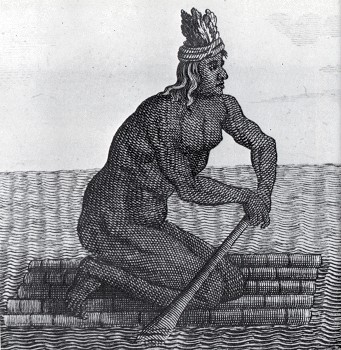
surfresearch.com.au
roberts and shackleton : rafts and canoes, california, 1983
roberts and shackleton : rafts and canoes, california, 1983
|
|
|
|
|
|
 |
surfresearch.com.au
roberts and shackleton : rafts and canoes, california, 1983 |
 |
Rafts and Floats A "man of California fishing on his bark log " was produced for the English seafarer George Shelvocke and first published in london in 1726. With the shortage of wood on some parts of the California coast it is highly likely that such tiny rafts were improvised for short trips to seal and mussel rocks just offshore. Bark log was the English seaman's term for a log raft. [caption, page 5] |
 |
The French
traveller Louis Choris drew a tule balsa in San
Francisco Bay in 1816 and published it in his
Voyage pittoresque du Monde in 1822. The double-bladed paddles are correct for that region and they recur along the Santa Barbara Channel and again around the southern end of Baja California. The two containers at the stern are baskets for fish or food. [caption, page 9] |
The Pomos, who were such masters of basket-making, fashioned finely made, boat-like balsas.

 |
The rising
bow and stern of this cane float give it a
distinct boat
shape even though it has no interior. When more than one person stood on these craft, the ends rose slightly. The boatman, a Seri Indian from Kino Bay, Mexico, is using a pole, but double paddles were used in deep water. [cropped] |
Dampier, William: Dampier's voyages. Ed. by John Masefield. 2 vols. London: 1906.
Kenneth G. Roberts and Philip
Shackleton:
The Canoe - A History of the Craft from Panama to the Arctic MacMillan of Canada, Toronto, 1983. |
 |

|
|
|
|
|
|